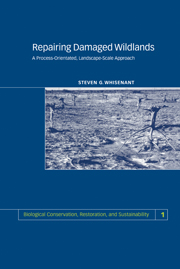Book contents
- Frontmatter
- Contents
- Preface
- Acknowledgments
- 1 Wildland degradation and repair
- 2 Assessing damage to primary processes
- 3 Repairing damaged primary processes
- 4 Directing vegetation change
- 5 Selecting plant materials
- 6 Site preparation and seedbed management
- 7 Planting
- 8 Planning repair programs for wildland landscapes
- Literature cited
- Index
4 - Directing vegetation change
Published online by Cambridge University Press: 03 December 2009
- Frontmatter
- Contents
- Preface
- Acknowledgments
- 1 Wildland degradation and repair
- 2 Assessing damage to primary processes
- 3 Repairing damaged primary processes
- 4 Directing vegetation change
- 5 Selecting plant materials
- 6 Site preparation and seedbed management
- 7 Planting
- 8 Planning repair programs for wildland landscapes
- Literature cited
- Index
Summary
Introduction
Having developed preliminary repair objectives; assessed hydrologic, nutrient cycling, and energy capture processes; and designed alternative strategies for repairing damaged primary processes, we need strategies for directing vegetative change. Now it is necessary to devise management strategies that continue developing the vegetation to: conserve soil, nutrient and organic resources; return fully functional hydrologic, nutrient cycling and energy capture processes; and create self-repairing landscapes that provide the goods and services necessary for ecologic and socioeconomic sustainability.
Will the site recover within an acceptable time frame in the absence of active repair efforts? If so, will it provide the desired combination of goods and services? Improving the management of ecosystem consumption (i.e., livestock, timber harvest, fodder harvest) is usually the best strategy for relatively intact sites. Additional degradation makes it necessary to actively manipulate the existing vegetation by reducing some species (with fire, herbicides, mechanical, or biological control methods) and/or adding others (with seeding or transplanting seedlings). Denuded or depauperate sites that can neither stabilize the site nor achieve management objectives require the addition of more plants.
Species performance, site availability, and species availability influence the direction and pace of vegetation change. Each of these causes has a set of contributing processes or conditions and defining factors. This organization of causes, processes and defining factors provide a convenient format to design repair strategies for specific problems. These management actions range from those with immediate effects (e.g., weed control, plant removal, or seedbed preparation) to those actions with longer-term objectives (e.g., establishing shrubs on degraded sites to collect wind-blown seed or attract birds that import seed).
- Type
- Chapter
- Information
- Repairing Damaged WildlandsA Process-Orientated, Landscape-Scale Approach, pp. 100 - 127Publisher: Cambridge University PressPrint publication year: 1999



